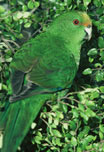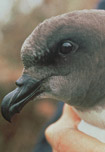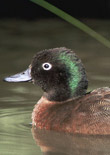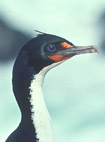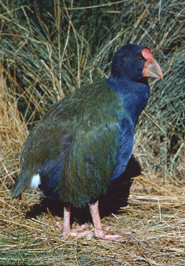 |
|
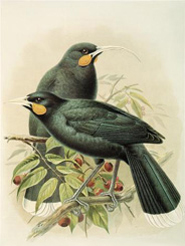
|
|
 |
|
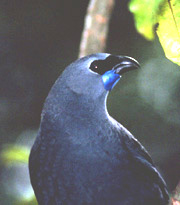 |
|
 |
|
|
|
|
|
 |
|
|
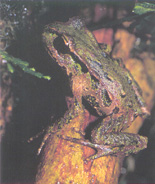 |
|
| |

NZ petrel 'returns' from the dead
"Scientists are preparing to carry out a DNA comparison of a small ocean-roaming seabird which is expected to show that it is a 'resurrected'…"
New Zealand Herald
9 November 2005
Angels watch over at-risk flock
"Eight endangered bird species have found a guardian angel on a remote island in the Chatham Islands - the Department of Conservation."
New Zealand Herald
1 February 2005
Remote Chatham Islands experiencing a cultural revival
"Go to Manukau Point at the southeastern tip of Chatham Island ... and you have reached the edge of the Earth..."
New Zealand Herald
17 May 2005
Fears for future of rescued parrots
"The emergency evacuation of parrot chicks from a South Island forest has critics asking
whether the birds will become permanent refugees from the mainland."
New Zealand Herald
29 April 2004
Black robins claw back from brink
"Just 15cm tall and limited to land masses in the Chatham Islands group, the Chatham Islands black robin remains on the endangered list."
New Zealand Herald
7 January 2004
A whiff of security for endangered bird
"A Whangarei ornithologist who rediscovered the rare Chatham Island taiko may have discovered a new way of attracting the endangered birds for research..."
New Zealand Herald
30 December 2003
Egg find brings hope for rescue of the kakariki
"Seven eggs from the nest of a South Island parakeet have given conservation staff something
to smile about."
New Zealand Herald
25 December 2003
Rare parakeet races up the endangered list
"New Zealand's conservation agency is facing its most serious extinction in two decades."
New Zealand Herald
8 September 2003
Broody double-up for rare parakeet
"Yet more good news on the breeding front for native birds, this time for another endangered parrot, the orange-fronted parakeet."
New Zealand Herald
10 April 2002
Black stilt on the edge of extinction
"Twenty-four young black stilts (kaki) have been released at South Canterbury's Lake Tekapo as part of a joint DoC and Otago University project to save the bird…"
New Zealand Herald
17 January 2002
Parakeets get own name but the family's future looks dim
"The Department of Conservation has announced that a new species of native bird has been identified."
New Zealand Herald
15 August 2001
|
|
 |
|

Looking at the endangered status of New Zealand birds is an insight into how tenuous their existence is, their significance in the unique edge ecology of the country, their resilience to be able to come back from the brink of extinction with protection from introduced predators, and the innovative techniques of conservation biologists to save them.
Nine native birds are 'critically endangered' on the 2006 IUCN Red List of Threatened Species. Of these nine species, five are 'nationally critical', two are 'nationally endangered', and one is in 'serious decline' in the 2005 New Zealand Threat Classification System. Another 17 birds are 'nationally critical', of which 12 have varied Red List status. Four species that were declared extinct have been rediscovered, and a snipe is a new discovery. Seven of the listed birds are endemic to the Chatham Islands, and 14 are found only on offshore islands. |
| |
Black robin Petroica traversi
The black robin was the world's rarest bird, and is New Zealand's comeback hero from the brink of extinction. Extinction could not have been any closer in 1980 when there was one female named Old Blue and her breeding partner and three other males, but the black robin has been brought back to a population of about 254. When Old Blue died it was announced in Parliament. Its status has been lowered to endangered on the 2007 IUCN Red List. The black robin is found only on three small islands in the Chatham Islands and remains 'nationally critical' on the 2005 NZ Threat Classification System.
 See more on Chatham Island birds See more on Chatham Island birds
 View 4 larger images View 4 larger images |
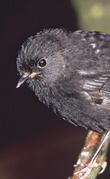 |
Orange-fronted parakeet Cyanoramphus malherbi
The number of orange-fronted parakeet plummeted 75 percent in three years, after it was declared a separate species in 2001. It has very quickly become one of New Zealand's most critically endangered birds. Only 100-200 birds remain in two valleys in Arthurs Pass National Park and Lake Sumner Forest Park in North Canterbury. Birds have been translocated to predator-free Chalky Island in Fiordland where it was found to be breeding in 2006.
 View larger image View larger image |
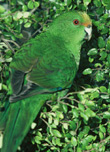 |
Black stilt (Kaki) Himantopus novaeseelandiae
Kaki are a wading bird endemic to New Zealand, with all black plumage and long skinny red legs. When Europeans settled, kaki were common throughout the country's rivers and wetlands. As rivers were channelised and wetlands drained, and introduced predators spread, their total number dwindled to a low of 23 by 1981. Kaki are now restricted to the rivers and wetlands of the Mackenzie Basin in South Canterbury. They have been intensely managed since 1981, and captive breeding and release has increased the population.
 View 5 larger images View 5 larger images |
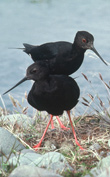 |
|
The kakapo is one of the world's most critically endangered birds, living dangerously
close to extinction for more than half a century. It is the world's heaviest parrot,
and the only flightless and nocturnal parrot. After many years of holding on with just
a few females in New Zealand's most extensive controlled breeding program, the future
looks better for kakapo since 22 chicks hatched in 2002, bringing the total up to 84 birds.
 See more See more
 Hear the booming call of male kakapo
Hear the booming call of male kakapo
[needs RealPlayer to run]
 INSTALL REALPLAYER INSTALL REALPLAYER |
 |
New Zealand storm-petrel Oceanites maorianis
The New Zealand storm-petrel was known only from three museum specimens from the mid-19th century. After it was declared extinct with no recorded sightings for more than 150 years, it was seen in 2003 near the Mercury Islands off the Coromandel Peninsula. There have been several sightings off Little Barrier Island in the Hauraki Gulf, and three birds were banded and fitted with transmitters in 2006 near the Hen and Chickens Islands, but their breeding location has not yet been found. Photo Copyright © Brent Stephenson 2005 www.eco-vista.com
 View larger image View larger image |
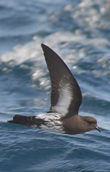 |
The taiko, also known as the magenta petrel, is endemic to the Chatham Islands. It was thought to be extinct for 111 years before David Crocket miraculously rediscovered it in 1978. It was nearly another decade before the first burrow was found in 1987. The Chatham Island taiko is one of the world's rarest seabirds and one of New Zealand's most critically endangered species, living on the very brink of extinction with a population of less than 150 birds.
 See more See more
 View larger image View larger image |
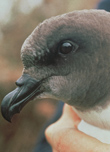 |
|
The Campbell Island teal, which is the world's rarest duck, is one of only four flightless ducks, and is historically endemic to Campbell Island and the tiny islet Dent Island in the subantarctic ocean southeast of the New Zealand mainland. It was declared extinct until 20 teal were discovered on Dent Island in 1975. After a 20-year captive breeding programme, 153 birds were sent back in three translocations from 2004 to 2006 to occupy their former range, and are now breeding on Campbell Island.
 See more
See more |
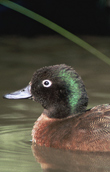 |
Chatham Island shag Leucocarbo onslowi
The cause the Chatham Island shag's decline is not known. It is endemic to the Chatham Islands group, and only breeds in a total area of one hectare on three islands. There are small colonies at Manakau Point on Chatham Island, and on Star Keys Island and Rabbit Island. Because of the small population, the status of the Chatham Island shag on the IUCN Red List was upgraded to 'critically endangered' in 2005.
 View larger images View larger images |
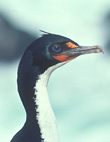 |
Chatham Island mollymawk Thalassarche eremita
The mollymawk which is also known as the Chatham albatross, is one of two albatrosses in the world that is 'critically endangered' on the IUCN Red List. It only breeds on Pyramid Island, a small rock outcrop in the Chatham Islands. During the breeding season it is mainly found within 300km of the colony along the continental shelf, while at other times it disperses west to Tasmania, and east to Chile and Peru. The 11,000 bird population shows little sign of decline, however, the island habitat has been damaged by storms, and the mollymawk is vulnerable to longline fishing.
 View larger images View larger images |
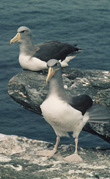 |
| |
 |
2005 New Zealand Threat Classification System
The following 10 birds are listed in the 2005 New Zealand Threat Classification System as 'nationally critical' which is the most critically endangered status. These species have various IUCN Red List classifications, or are not Red Listed, as shown in the right column. |
| |
Great egret (White heron) Egretta alba modesta
The white heron is a rare bird in New Zealand, and was almost lost because of the demand for feathers for women’s hats. The New Zealand population is at the extent of the E. alba modesta subspecies range, which also includes India, China, Japan and Australia. It is seen on rare occasions throughout New Zealand, but its' only breeding site is on the banks of the Waitangituna Stream at Okarito in South Westland where it was discovered in 1865. There were only four nests in 1941 at Okarito, however, since the area was declared a reserve and nesting was protected, numbers have stabilised with a population of 100 to 120.
 View larger image View larger image |
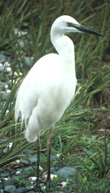 |
A tiny population of Campbell Island snipe was discovered in 1997, during a search for teal on Jacquemart Island, a 19ha inhospitable rock stack 1km off Campbell Island. Jacquemart is New Zealand's most southern piece of land in the Southern Ocean. The first naturalists that landed on Campbell Island in 1840 found no land birds - all of them had been wiped out by rats that got ashore from shipwrecks. After rat eradication on the main island in 2001, snipe have returned naturally, with about 30 birds found during the summer of 2006.
 View full image View full image |
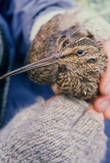 |
|
The takahe is the largest living member of the rail family which is found throughout the Southern Oceanic islands. Takahe were hunted until they were rarely found in the 19th century. None were seen after 1900 and it was declared extinct, but amazingly, 200 pairs were found in a remote region of Fiordland in 1948. The North Island takahe is extinct, but about 220 of the South Island species continue their dramatic brink of extinction existence.
 See more See more
 Hear the call of takahe Hear the call of takahe
Needs RealPlayer to run.
INSTALL REALPLAYER |
 |
Chatham Island pigeon (Parea)
Hemiphaga chathamensis
The parea is found in the Tuku Nature Reserve and in forest remnants in the Chatham Islands. The number of birds got as low as 40 in 1986. Parea made a remarkable recovery, mainly because of predator and hunting control, and by 1996 there were about 200 birds. H. chathamensis is distinguished by its larger body size, shorter wings and tail, and other appearance and structural differences from the mainland pigeon H. novaeseelandiae which is more prevalent throughout New Zealand and is listed as 'gradual decline'.
 View larger images View larger images |
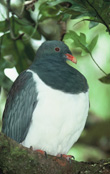 |
Chatham Island oystercatcher
Haematopus chathamensis
H. chathamensis is endemic to the Chatham Islands, and is found on South East Island, Pitt Island, Mangere Island, and Chatham Island. The population in 1998 was down to about 150 birds. After a more intensive management programme of 16 oystercatcher territories was introduced in 1998, that involved predator control, nest relocation and monitoring, and dune restoration, the population doubled by 2004 with 88 breeding pairs and a total of 311 birds.
 View larger images View larger images |
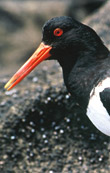 |
New Zealand shore plover (Tuturuata)
Thinornis novaeseelandiae
A population of only 130 critically endangered shore plover, a small wading bird, was all that remained on Rangatira (South East) Island in the Chatham Islands, until 14 chicks were hatched from eggs taken off the island to Mt Bruce in 1991. The captive breeding programme got an incredible boost when birds bred just one year later. Eight captive-bred shore plover were translocated to Motuora Island in the Hauraki Gulf as a trial in 1994, and another 50 birds have since been transferred to the island.
 View larger images View larger images |
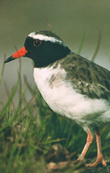 |
Southern New Zealand dotterel
Charadrius obscurus obscurus
The C. obscurus obscurus subspecies survives on Stewart Island with a population of about 200 birds. This group is remarkable for a shorebird because it nests on mountain tops. The Northern subspecies C. obscurus aquilonius nests just above the high tide mark of sandy beaches on the west and east coasts of the northern half of the North Island. Its status is 'sparse' but its' exposed nests are most vulnerable, and only a total of about 400 flock at 7 locations.
 View Northern NZ dotterel image View Northern NZ dotterel image |
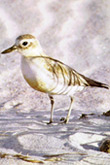 |
South Island brown teal
Anas chlorotis 'South Island'
A few of the South Island subspecies of brown teal survive in Fiordland. Fossil records show that brown teal once occupied a wider range than that of any other New Zealand anatid. Habitats were as diverse as coastal dunes, lagoons, lakes, waterways, kahikatea swamp forests, wet rimu forests and matai forests in low rainfall areas. The areas occupied ranged from Stewart Island marine habitat without freshwater, to silver beech and dry mountain beech forests up to an altitude of 800m.
 View full image View full image |
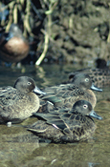 |
Rowi were described in 2003 as a separate species, after being identified in 1993 as the Okarito brown kiwi, a subspecies of the North Island brown kiwi, A. mantelli. It is the most critically endangered kiwi with less than 250 birds remaining. They occupy 10 sq.km in the South Okarito Forest between the Okarito and Waiho Rivers in Westland National Park. The Haast tokoeka population is less than 200 birds. Their area in the vicinity of the Cascade and Haast Rivers of South Westland, is separated from rowi by 150 km of forested ranges and coastal lowlands.  See more See more
 View full image View full image
|
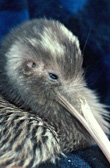 |
 |
|
| |

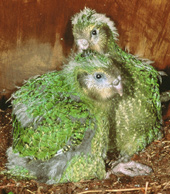 |
| |
2006 IUCN Red LIst of Threatened Species, and ...
2005 New Zealand Threat Classification System
Red List classifications are for species only. NZ classifications are for species or subspecies.
Black robin (Chatham robin)
Petroica traversi
Endangered
Nationally critical
Black stilt (Kaki)
Himantopus novaeseelandiae
Critically endangered
Nationally critical
Bounty Island shag
Leucocarbo ranfurlyi
Vulnerable
Nationally critical
Campbell Island snipe
Coenocorypha 'Campbell'
Nationally critical
Campbell Island teal
Anas nesiotis
Critically endangered
Nationally critical
Chatham Island mollymawk
Thalassarche eremita
Critically endangered
Serious decline
Chatham Island oystercatcher
Haematopus chathamensis
Endangered
Nationally critical
Chatham Island pigeon (Parea)
Hemiphaga chathamensis
Nationally critical
Chatham Island shag
Leucocarbo onslowi
Critically endangered
Nationally endangered
Chatham petrel
Pterodroma axillaris
Critically endangered
Nationally endangered
Codfish Island South Georgian diving petrel
Pelecanoides georgicus 'Codfish Island'
Least concern
Nationally critical
Common noddy (Brown noddy)
Anous stolidas pileatus
Least concern
Nationally critical
Haast tokoeka (kiwi)
Apteryx australis 'Haast'
Vulnerable
Nationally critical
Kakapo
Strigops habroptilus
Critically endangered
Nationally critical
Kermadec white-faced storm petrel
Pelagodroma marina albiclunis
Least concern
Nationally critical
New Zealand fairy tern
Sterna nereis davisae
Least concern
Nationally critical
New Zealand shore plover
Thinornis novaeseelandiae
Endangered
Nationally critical
New Zealand storm-petrel
Oceanites maorianis
Critically endangered
Data deficient
Orange-fronted parakeet
Cyanoramphus malherbi
Critically endangered
Nationally critical
Rowi (Okarito brown kiwi)
Apteryx rowi
Nationally critical
South Island brown teal
Anas chlorotis 'South Island'
Endangered
Nationally critical
Southern New Zealand dotterel
Charadrius obscurus obscurus
Endangered
Nationally critical
Taiko (Magenta petrel)
Pterodroma magentae
Critically endangered
Nationally critical
Takahe
Porphyrio hochstetteri
Endangered
Nationally critical
White heron
Egretta alba modesta
Nationally critical
White tern
Gygus alba royana
Least concern
Nationally critical
New Zealand's high number of 'critically endangered' birds
Nine of New Zealand's native birds are listed as 'critically endangered' on the 2006 IUCN Red List of Threatened Species, and one has recently been downgraded to 'endangered'. This is very high for such a relatively small country.
Seventeen United States birds, including many Hawaiian birds, are Red Listed as 'critically endangered' in a land area that is 36 times greater than that of New Zealand.
There are a total of 181 birds on the IUCN Red List classified as 'critically endangered'. The number of countries or locations identified in the list is 240. |
|
| |
Number of 'critically endangered' birds for a selection of countries |
|
| |
Brazil |
25 |
United States |
17 |
India |
12 |
New Zealand |
9 |
China |
8 |
Peru |
7 |
Nepal |
6 |
Malaysia |
5 |
Russia |
5 |
Chile |
3 |
Madagascar |
3 |
New Caledonia |
3 |
Australia |
2 |
Canada |
2 |
Fiji |
2 |
Jamaica |
2 |
Costa Rica |
1 |
Norfolk Island |
1 |
Panama |
1 |
Samoa |
1 |
Spain |
1 |
United Kingdom |
1 |
Germany |
0 |
Greenland |
0 |
Nigeria |
0 |
South Africa |
0 |
Sweden |
0 |
Switzerland |
0 |
Zambia |
0 |
| |
Photo Credit
Center top: Black robin, Don Merton, South East Island 2004 DoC
Center 2nd down: Orange-fronted parakeet, DoC
Center 3rd down: Black stilt, Dick Veitch, Cass River 1977, DoC
Center 4th down: Kakapo, DoC
Center 5th down: New Zealand storm-petrel, Copyright© Brent Stephenson 2005 eco-vista.com
Center 6th down: Taiko, Graeme Taylor, DoC
Center 7th down: Campbell Island teal, DoC
Center 8th down: Chatham Island shag, Rod Morris, Chatham Islands 1976, DoC
Center 9th down: Chatham Island mollymawk, C.J.R. Robertson, Pyramid Island 1974, DoC
Center 10th down: Chatham petrel, Don Merton, South East Island 1972, DoC
Center 11th down: White heron, Peter McClelland, South Westland 1989, DoC
Center 12th down: Campbell Island snipe, Jeremy Carroll, Jacquemart Island 1997, DoC
Center 13th down: Takahe, DoC
Center 14th down: Chatham Island pigeon, Ian Flux, Chatham Islands 1994, DoC
Center 15th down: Chatham Island oystercatcher, Don Merton, South East Island 2000, DoC
Center 16th down: New Zealand shore plover, Don Merton, South East Island 2004, DoC
Center 17th down: Northern New Zealand dotterel, Copyright © Geoff Moon
Center 18th down: North Island brown teal, Dick Veitch, Great Barrier Island 1974, DoC
Center 19th down: Rowi, C.D. Roderick, Tai Poutini Conservancy 1979, DoC
Right top: Kakapo
Left 3rd down: Takahe
Left 5th down: Campbell Island teal
Left 7th down: Kokako
Left 8th down: Tusked weta
Left 9th down: Archey's frog
All DoC images Crown Copyright © Department of Conservation
Left 7th down: Kauri, Alexander Turnbull Library
Illustration Credit
Left 3rd down: John Gerrard Keulemans 1842-1912,
Huia Heteralocha acutirostris 1888
Permission of the Alexander Turnbull Library, Wellington, New Zealand must be obtained before
any re-use of this image. |
|
| |
 |
| |
 |
|
|

